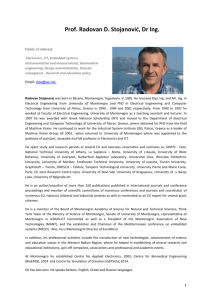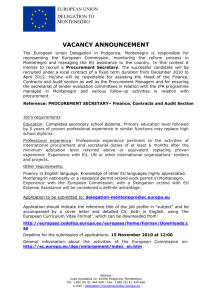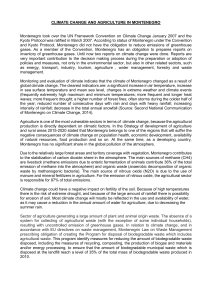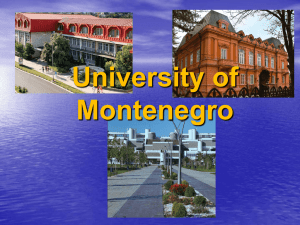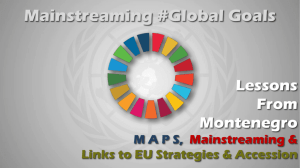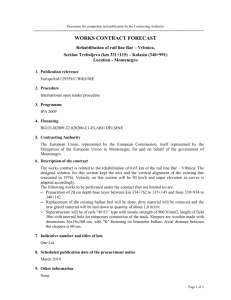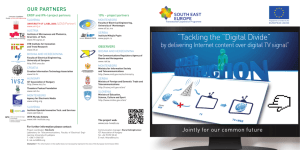Woman and University in Montenegro Mr. Sci Mirjana Popoviý
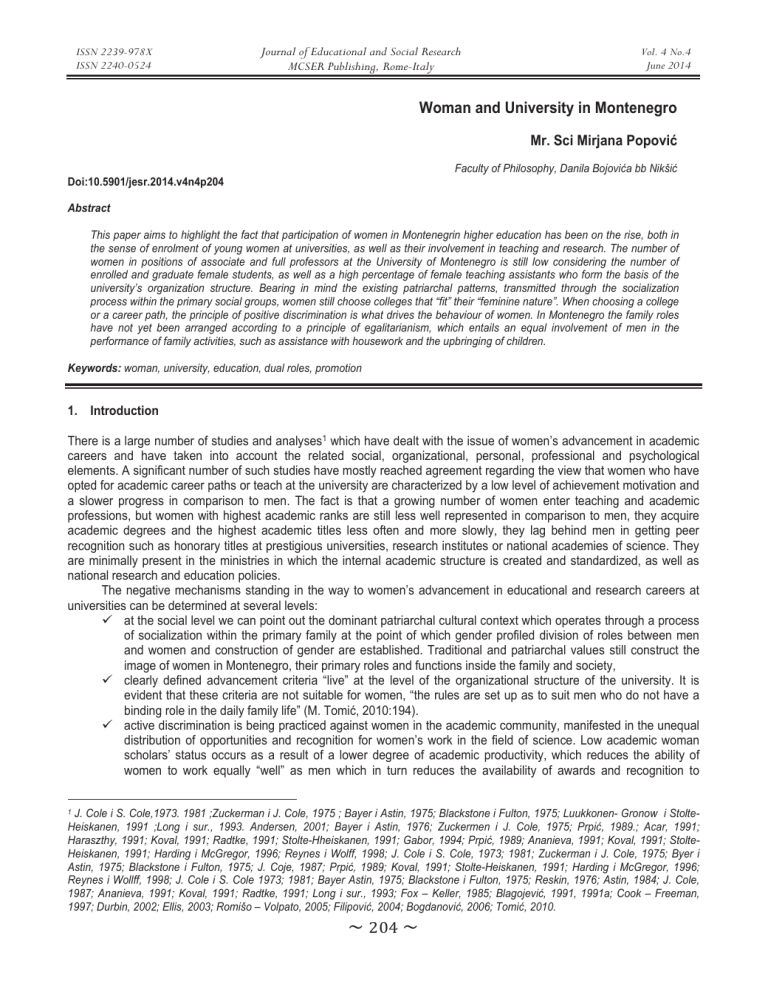
ISSN 2239-978X
ISSN 2240-0524
Journal of Educational and Social Research
MCSER Publishing, Rome-Italy
Vol. 4 No.4
June 2014
Woman and University in Montenegro
Mr. Sci Mirjana Popovi ý
Faculty of Philosophy, Danila Bojovi ü a bb Nikši ü
Doi:10.5901/jesr.2014.v4n4p204
Abstract
This paper aims to highlight the fact that participation of women in Montenegrin higher education has been on the rise, both in the sense of enrolment of young women at universities, as well as their involvement in teaching and research. The number of women in positions of associate and full professors at the University of Montenegro is still low considering the number of enrolled and graduate female students, as well as a high percentage of female teaching assistants who form the basis of the university’s organization structure. Bearing in mind the existing patriarchal patterns, transmitted through the socialization process within the primary social groups, women still choose colleges that “fit” their “feminine nature”. When choosing a college or a career path, the principle of positive discrimination is what drives the behaviour of women. In Montenegro the family roles have not yet been arranged according to a principle of egalitarianism, which entails an equal involvement of men in the performance of family activities, such as assistance with housework and the upbringing of children.
Keywords: woman, university, education, dual roles, promotion
1.
Introduction
There is a large number of studies and analyses 1 which have dealt with the issue of women’s advancement in academic careers and have taken into account the related social, organizational, personal, professional and psychological elements. A significant number of such studies have mostly reached agreement regarding the view that women who have opted for academic career paths or teach at the university are characterized by a low level of achievement motivation and a slower progress in comparison to men. The fact is that a growing number of women enter teaching and academic professions, but women with highest academic ranks are still less well represented in comparison to men, they acquire academic degrees and the highest academic titles less often and more slowly, they lag behind men in getting peer recognition such as honorary titles at prestigious universities, research institutes or national academies of science. They are minimally present in the ministries in which the internal academic structure is created and standardized, as well as national research and education policies.
The negative mechanisms standing in the way to women’s advancement in educational and research careers at universities can be determined at several levels:
9 at the social level we can point out the dominant patriarchal cultural context which operates through a process of socialization within the primary family at the point of which gender profiled division of roles between men and women and construction of gender are established. Traditional and patriarchal values still construct the image of women in Montenegro, their primary roles and functions inside the family and society,
9 clearly defined advancement criteria “live” at the level of the organizational structure of the university. It is evident that these criteria are not suitable for women, “the rules are set up as to suit men who do not have a binding role in the daily family life” (M. Tomi ü , 2010:194).
9 active discrimination is being practiced against women in the academic community, manifested in the unequal distribution of opportunities and recognition for women’s work in the field of science. Low academic woman scholars’ status occurs as a result of a lower degree of academic productivity, which reduces the ability of women to work equally “well” as men which in turn reduces the availability of awards and recognition to
1 J. Cole i S. Cole,1973. 1981 ;Zuckerman i J. Cole, 1975 ; Bayer i Astin, 1975; Blackstone i Fulton, 1975; Luukkonen- Gronow i Stolte-
Heiskanen, 1991 ;Long i sur., 1993. Andersen, 2001; Bayer i Astin, 1976; Zuckermen i J. Cole, 1975; Prpi ü , 1989.; Acar, 1991;
Haraszthy, 1991; Koval, 1991; Radtke, 1991; Stolte-Hheiskanen, 1991; Gabor, 1994; Prpi ü , 1989; Ananieva, 1991; Koval, 1991; Stolte-
Heiskanen, 1991; Harding i McGregor, 1996; Reynes i Wolff, 1998; J. Cole i S. Cole, 1973; 1981; Zuckerman i J. Cole, 1975; Byer i
Astin, 1975; Blackstone i Fulton, 1975; J. Coje, 1987; Prpi ü , 1989; Koval, 1991; Stolte-Heiskanen, 1991; Harding i McGregor, 1996;
Reynes i Wollff, 1998; J. Cole i S. Cole 1973; 1981; Bayer Astin, 1975; Blackstone i Fulton, 1975; Reskin, 1976; Astin, 1984; J. Cole,
1987; Ananieva, 1991; Koval, 1991; Radtke, 1991; Long i sur., 1993; Fox – Keller, 1985; Blagojevi ü , 1991, 1991a; Cook – Freeman,
1997; Durbin, 2002; Ellis, 2003; Romišo – Volpato, 2005; Filipovi ü , 2004; Bogdanovi ü , 2006; Tomi ü , 2010.
̱
ʹͲͶ
̱
ISSN 2239-978X
ISSN 2240-0524
Journal of Educational and Social Research
MCSER Publishing, Rome-Italy
Vol. 4 No.4
June 2014 women while the internal organization of academic structure itself contributes to the marginalized position of women in academia.
9 women’s desire to simultaneously satisfy two sets of “needs” is also recognised as an obstacle (S. Vuki ü evi ü ,
2005). The “duality” of family and business lives often acts as a burden and significantly reduces any chance of vertical advancement within the organizational structure of an academic institution (Tomi ü , 2010:183).
2.
Women and Education in Montenegro
Education is a part of the social practice in which the data have generally been systematically and regularly gathered and in the framework of which the general differences by gender have been recorded. The statistical data collected in this area can thus serve as a basis for understanding the extent to which women participate in the Montenegrin education system.
Looking at the census figures, women in Montenegro slightly outnumber the males (census was taken in
Montenegro from 1921 till 2011). According to Monstat 2 , the lowest rate of masculinity was recorded in 2003 when the recorded sex ratio was 969 men per 1,000 women.
Literacy statistics and the percentage of female population included into the institutionalized forms of education are some of the main parameters on the basis of which we can conclude whether a certain society is in the process of transition from the traditional to the modern. The consequences of late and non-systematic inclusion of women into the education system are well illustrated by the data contained in Table 1. Judging from the data of the last census (2011) one can note a very high percentage of women (80.8%) in the structure of the part of the Montenegrin population which has not been involved in any type of formal education.
Table no. 1: Population of 15 and over the age of age of 15 according to gender distribution of the highest academic degree earned, 2011 Census
The highest degree earned
No degrees
Incomplete primary education
Primary education
Two-year university degree and bachelor degree
Higher education, four-year university degree, fine arts academy
Postgraduate master’s studies
Doctoral degree
Male %
19,2
27,0
45,0
57,5
50,0
42,5
73,7
Female % Total %
80,8 100
73,0
55,0
100
100
42,5
50,0
47,6
26,3
100
100
100
100
One of the most important modernization processes in Montenegro is the entry of women into the sphere of education, especially the area of higher education. Although the process of inclusion of women into the system of higher education started relatively late, in the mid 20 th and early 21 st century, it is evident that nowadays more women than men enrol at and graduate from the University of Montenegro (Tables no. 2 and 3). There have been more women entering
Montenegrin universities for the period between 2008 – 2011, not only the bachelor’s programs, but also the specialist and postgraduate studies. For example, in 2010 women had an advantage of 61.6% over men specialist studies, and
59.3% master’s studies.
Table no. 2: Number of female vs. male students enrolled from 2008 – 2011.
Year
2007/2008
2008/2009
2009/2010
2010/2011
Women %
53,6
53,9
53,2
53,0
Men %
46,4
46,1
46,8
47,0
Total %
100
100
100
100
2 Statistical Office of Montenegro
̱
ʹͲͷ
̱
ISSN 2239-978X
ISSN 2240-0524
Journal of Educational and Social Research
MCSER Publishing, Rome-Italy
Vol. 4 No.4
June 2014
Table no. 3: Number of female vs. male students who have graduated from 2008– 2011.
Year
2007/2008.
2008/2009.
2009/2010.
2010/2011.
Gender distribution %
Nursery
Primary school
High school
Higher education
Table no. 5: Who manages schools?
Women %
64,07
61,34
61,34
59,85
Women %
97,7
72,9
61,1
43,5
Men %
35,92
38,65
38,65
40,14
Total %
100
100
100
100
The process of inclusion of women into education implied women’s massive entry into the labour market, as well as female emancipation in all fields. However, once women entered the education process, and thus made access into the labour market, they were faced with the division of degrees or occupations according to whether they were suited to specific gender roles. While enrolling in courses in Montenegro it is still common to opt for a type of study according to the unwritten rule, which is based around the division onto the male and female occupations. Analysing the data from
Table no. 4, one can note that the women in the educational process are tied to those occupations that are traditionally appropriate to their “feminine” nature, i.e. to those personality traits that are created in the process of socialization of female children in Montenegro. Despite the high rate of participation of women in the sphere of education the recent data from Monstat (2011) indicates that the percentage of women is significantly lower at the levels of the educational process, which imply a certain amount of prestige, social power and material wealth. (Table no. 5)
If we compare the data from the table no. 4 on the representation of women in education with the data on the percentage of women in managerial positions, i.e. positions of school and kindergarten principals (Table no. 5) we will get a clearer picture. Namely, the Monstat data (2011) suggests that “every 134 th woman employed in the education sector is a principal, while every 18 th man employed in the same sector is a principal” (Men and Women in Montenegro, 2011:55).
Table no. 4: The gender distribution of those employed in the educational system in Montenegro for 2010/2011:
Men %
5,3
27,1
38,9
56,5
Total %
100
100
100
100
Gender distribution
Women
Men
Nursery %
19,04
80,95
100
Primary school %
23,31
76,68
100
Secondary school %
14,28
85,71
100 Total
If we take into account the information provided, we will notice that a majority of women working in the education sector are employed in preschool institutions, while the smallest at the universities. Today, 43.5% of the employees at the
University of Montenegro are women, the most of whom are at the bottom of the academic hierarchy and hold the positions of teaching assistants (Monstat, 2011).
At the University of Montenegro women occupy a large part of the academic hierarchy both at the so-called
“feminine” and the “masculine” university programmes. However, when it comes to the top of the pyramid, the situation is qualitatively different, the percentage of women among full and associate professors is low, even when it comes to the
Arts and Law Faculties at which a high percentage of enrolled students, even close to 90% of student body, are women.
Thus, for example, at the Faculty of Philosophy 36.3% full professors are women, while 69.5% of associates with an academic title and 85.7% of associates without an academic title are women. Primary, middle and high school teachers are educated at the programs of study at the Faculty of Philosophy where men prevail as teachers in the highest positions, create textbooks and curricula. Men are also found in most of the decision-making positions at the University of
Montenegro (deans, members of expert committees, review committees, governing bodies). While at the University of
Montenegro the majority of employees are male, the fact that there is an increased number of female teaching assistants suggests that certain changes might be on the way. Employment at the University itself requires long-term and continuous learning, and women’s need for starting families may prove to be an obstacle. Although this work involves flexible working hours, it on the other hand requires additional commitment and investment that women can hardly meet:
̱
ʹͲ
̱
ISSN 2239-978X
ISSN 2240-0524
Journal of Educational and Social Research
MCSER Publishing, Rome-Italy
Vol. 4 No.4
June 2014 participation in seminars, study visits, research.
3.
Research Results
This research was conducted at the University of Montenegro in the period from September 2012 till November 2013 and was carried out for the purposes of a doctoral dissertation entitled The gender dimension in the development of higher education in Montenegro . The principal goal of this research was to explain an increase in the number of women included into the process of development of the University of Montenegro. This trend has been noted both with respect to female students, as well as women who actively participate in the educational activities and research at the university. The focus of our research was particularly on determining the place and role of women in the higher education system.
3.1
Sample and research methods
The sample size was determined according to the number of women (teaching assistants, assistant, associate and full professors) and the number of enrolled female students at the state University of Montenegro. The study involved a sample of 450 respondents included in the questionnaire method and 40 subjects who were included into the focus group method. The sampling units for the survey and the focus groups were selected from the list of registered students, i.e. women engaged in the higher education system, which were obtained in the qualitative and quantitative analysis of the existing data from the University of Montenegro as well as Monstat’s statistical yearbooks. The survey sample included
250 female students, from 18 to over 30 years of age. It also included 200 female university teachers aged 23 to over 53 years of age. Focus groups discussions included 40 women of which 20 were female students and 20 female professors.
For the needs of the research two focus groups were formed out of each of the respondent groups:
1.
female students/teachers from the humanities programs
2.
female students/teachers from the science programs.
Bearing in mind the above, we collected the empirical data using the standard tools and techniques we have designed for the purposes of this research: a questionnaire and a focus group study. Due to the nature of the sample we thought it would be reasonable to construct two types of questionnaires, one which will serve the collection of data within the student population and the other which will be designed for data collection within the population of women who are actively involved in teaching and research at the university.
3.2
Respondents’ independence when selecting their university program
The survey results show a high percentage of autonomy in the process of selecting universities within the test groups.
87.6% female students and 78% of female teachers had personally chosen their university degree. We believe that this choice independence lies in the reservoir of female gender habitus, formed by the primary socialization which is still based around the traditional and patriarchal divisions and values in Montenegro. In practice, most women seek to strike a balance between their family and professional commitments. Whether the balance will be established depends largely on the individual characteristics of women, but at a more significant level on the social context in which women make their choices and decisions.
In order to support the above, we quote the following statements from the focus group members:
“When I told my family I wanted to study mechanical engineering, this was not quite well received. Especially in the beginning my mother was against it, arguing that neither the school nor the job were suited for a girl.” Student, 21 years of age, Faculty of Engineering.
“Being a language teacher or a translator was perfectly acceptable, especially a teaching job which gives women more time for motherhood and family. In my family, everyone was unanimous that this was the right job for a woman.”
Student, 22 years of age, humanities.
3.3
Respondents’ Marital Status
Out of 46% of the married female teachers, 52% have children, often two (27%). 13.5% of them have one, 10.5% three and only 2% of the respondents have four children. When it comes to the teacher respondents, 41.5% of them have spouses with a university degree (30.5%), MA (7.5%) or doctoral degrees (3.5%).
̱
ʹͲ
̱
ISSN 2239-978X
ISSN 2240-0524
Journal of Educational and Social Research
MCSER Publishing, Rome-Italy
Vol. 4 No.4
June 2014
3.4
Type of support respondents receive in their families
The most important support for further development the female teachers receive from their parents (50.5%) and their husbands (28.5%). The husband support figures are significant if we bear in mind that 46% of the respondents are married. What is particularly interesting is the kind of support they receive. In fact, in 60% of cases this is moral support.
Given the high occurrence of this type of support to the respondents in their families, it is natural that the following question will be raised: what is actually the moral support, how is specifically it manifested? From the analysis of the focus group discussions, we conclude that most often this is verbal support, especially from a partner. Women are happy if their partners do not prevent them from their activities, if they express a positive attitude towards their training, are not setting limitations or in a worst case scenario imposing certain bans on them. Men do not practically help with housework and there is no true division of household and family responsibilities. The family gender roles in Montenegro still operate based on traditionalism and gender divisions which survive with the rules of what women can, should, cannot and should not do because it goes against her “feminine nature”. In fact, according to the data from our survey only 11, 5% of our respondents share family responsibilities with their partners. Division of the family responsibilities is changing more slowly than the gender division of labour. The problem of labour feminization is usually associated with the work in a company, i.e. the public sphere of work, while the problem of work feminization is rarely considered in relation to “home” work.
“Exactly from the standpoint of work actors, given their dominant impact on the characteristics of the work situation, work at home represents “women’s world” while work in the company is “men’s world” (Miloševi ü , 2004: 265-266). Domestic work is very little appreciated or completely devalued, while working in the public sphere provides opportunities for social confirmation.
At the level of everyday life women’s subordination is most strongly visible in their family life, or in the distribution of tasks within the family and parental responsibilities.
In order to support the above claim we offer the following statements obtained by the focus group discussion:
“Men in Montenegro often say that the house rests upon a woman, that there is a great woman behind any successful man, but I think it all ends up in the verbal expression. In case the words were to be put in action or the woman’s career were to be supported, everything is forgotten.” associate professor, 52 years of age, married, two kids, humanities.
“Woman is today in an even worse position than she was 100 years ago. She did not have so many commitments then, she did not go to work. Today, women are much more knowledgeable, they work three times more, and nothing has essentially been changed, men are still dominating in all fields” Associate professor, 32 years of age, married, one child, humanities.
“I think that no man would be able to complete all of the home and family duties that women manage to, no matter what he did. I often have a feeling that women themselves are unaware of how much work they do, what kinds of things they do, they somehow accept everything in a completely natural way.” Associate professor, 40 years of age, married, one child, Faculty of Engineering.
“I'm married, I cannot say much about the support I am given. I complete all of the home obligations alone, my husband jumps in from time to time. Verbally he does support me, does not ask me questions if I go to seminars, scientific conferences. However, I cannot afford to go to a study visit that lasts for a longer period of time because the children are still little.” Associate professor, 51 years of age, married, two children, humanities science.
“The concrete support from which I can benefit the most is provided by my parents. They take care of my children whenever I write a paper, prepare a lecture or for an academic conference. My husband sometimes helps with some little things, but this support is not permanent, it is more on a case to case basis, but he surely supports me verbally.”
Associate, 40 years of age, married, two children, humanities.
“Men and women do not have equal opportunities for progress at the university, especially at our university. Men in
Montenegro rarely have any obligations at home. Women, on the other hand, have to do everything; they try very hard and are much dedicated. People often tell me that I wanted to study, you have chosen it, so take it now. If we on top of it add traditionalist values which are very much present at the university, women should then make twice or three times as much effort as to advance in their careers, acquire the titles, write papers”. Associate professor, 51 years of age, married, two children, humanities science.
4.
Instead of the Conclusion
It is evident that from 1974, the year the University of Montenegro was founded, the number of women who teach has significantly increased. However, this cannot be regarded as a consequence of the process of emancipation of women in the academic and scientific structure at the University of Montenegro. This process is a part of a broader process which is evident in other areas of social life, and which is defined by a significant number of authors as the process of feminization
̱
ʹͲͺ
̱
ISSN 2239-978X
ISSN 2240-0524
Journal of Educational and Social Research
MCSER Publishing, Rome-Italy
Vol. 4 No.4
June 2014 of professions (A. Mili ü , 2002, M. Filipovi ü , 2003; M. Blagojevi ü , 2005; D. Popovi ü , D . Duha þ ek, 2009).
Namely, the social status and economic power that have once been the basis of a profession are declining, in this case, the social status and economic power of teaching and scientific activities at the university. An academic career ceases to be a prestigious profession, and women fill in the space that men ceased to be interested in as it does not provide them any longer the expected level of social power and profit.
Women are at the bottom of the academic hierarchy at the University of Montenegro. A balance struck at the lower levels of the university hierarchy can lead us to the conclusion that in the future the balance may be transferred to higher positions keeping in mind that a unique form of progress operates at the university. However, the social practices and the data we have obtained in our research, provide a qualitatively different picture. Family obligations are slowing down women's professional accomplishments especially when it comes to university careers which are hierarchically structured. Rules of advancement at the university, university organizations, as well as the overall socio cultural context of Montenegrin society reproduce a gender structuring at the level of university, leading to segregation of women, while the overall mechanisms of the social system maximize the selection amongst them.
References
Blagojevi ü , M. (1991): Žene izvan kruga, profesija i porodica , Institut za sociološka istraživanja Filozofskog fakulteta u Beogradu,
Beograd.
Blagojevi ü , M. (2000): Mapiranje mizoginije u Srbiji, Asocijacije za žensku inicijativu Beograd.
Blagojevi ü , M. (2002): Mapiranje mizoginije u Srbiji , Tom I, AŽIN, Beograd.
Blagojevi ü , M. (2002): ’’Ko sme da zna? Koncentri þ ni krugovi i isklju þ ivanja znanja, Mapiranje mizoginije u Srbiji II tom, 39-55.
Blagojevi ü , M. (2005): Mapiranje mizoginije u Srbiji , Tom II, AŽIN, Beograd.
Filipovi ü , M. (2003): Društvena mo ü žena u Crnoj Gori , CID, Podgorica.
Filipovi ü , M. (2008): Vladavina muškarca Pjera Burdjea, Glasnik odjeljenja društvenih nauka, Crnogorska akademija nauka i umjetnosti.
Mili ü , A. (1994): Žena, Politika, Porodica , Institut za politi þ ke studije, Beograd.
Mili ü , A. (1998): Patrijarhalni poredak, revolucija i saznanje o položaju žene, 551-561, Srbija u modernizacijskim procesima 19. i 20. veka, II tom, Institut za noviju istoriju Srbije, Beograd.
Mili ü , A. (2001): Sociologija porodice , ý igoja, Beograd.
Mili ü , A. (2002): Mapiranje mizoginije u Srbiji , II tom, Univerzitet i mizoginija , (69-75), Asocijacije za žensku inicijativu, Beograd.
Mili ü , A. (2002): Ženski pokret na raskrš ü u milenijuma , Odeljenje za sociologiju Filozofskog fakulteta, Beograd.
Miloševi ü , B., Šljuki ü , M., Vuk þ evi ü , T. (2011): Žene u zagrljaju diskriminacije , OLD Commerce, Novi Sad
Popovi ü , D. i Duha þ ek, D. (2009): Od Ciriškog kruga do Studija roda: Rodna ravnopravnost i visoko obrazovanje u Srbiji, FPN, Godišnjak
2009, 681-693, Beograd.
Tomi ü , M. (2010): Žene u akademskoj profesiji i muška dominacija, Sociologija , 2, Beograd
Magna Charta Universitatum , Bolonja 1988.
Vuki ü evi ü , S. (2005): Sociologija – filozofske predpostavke i temeljni pojmovi , Filozofski fakultet Nikši ü , Plato Beograd.
Žene i muškarci u Crnoj Gori , (2012): Zavod za statistiku Crne Gore MONSTAT, Podgorica.
̱
ʹͲͻ
̱
